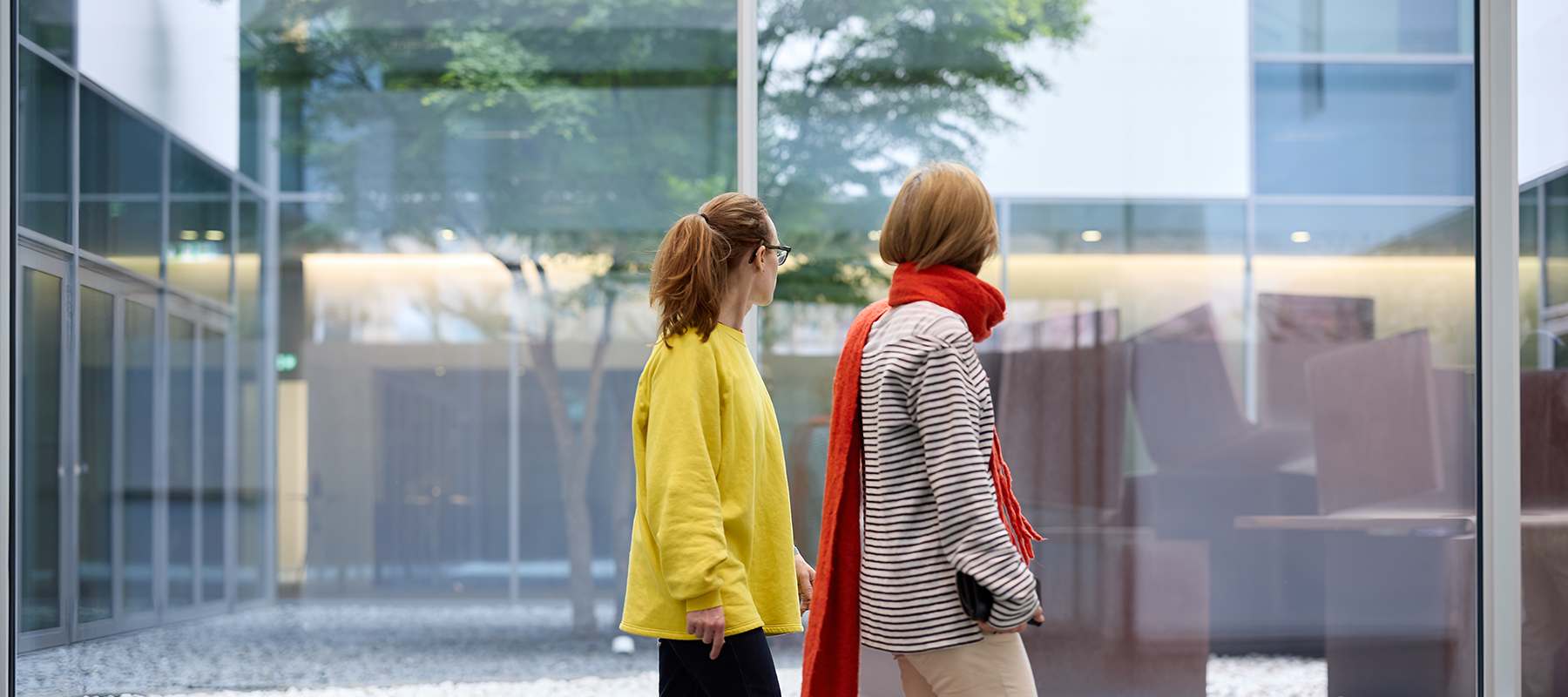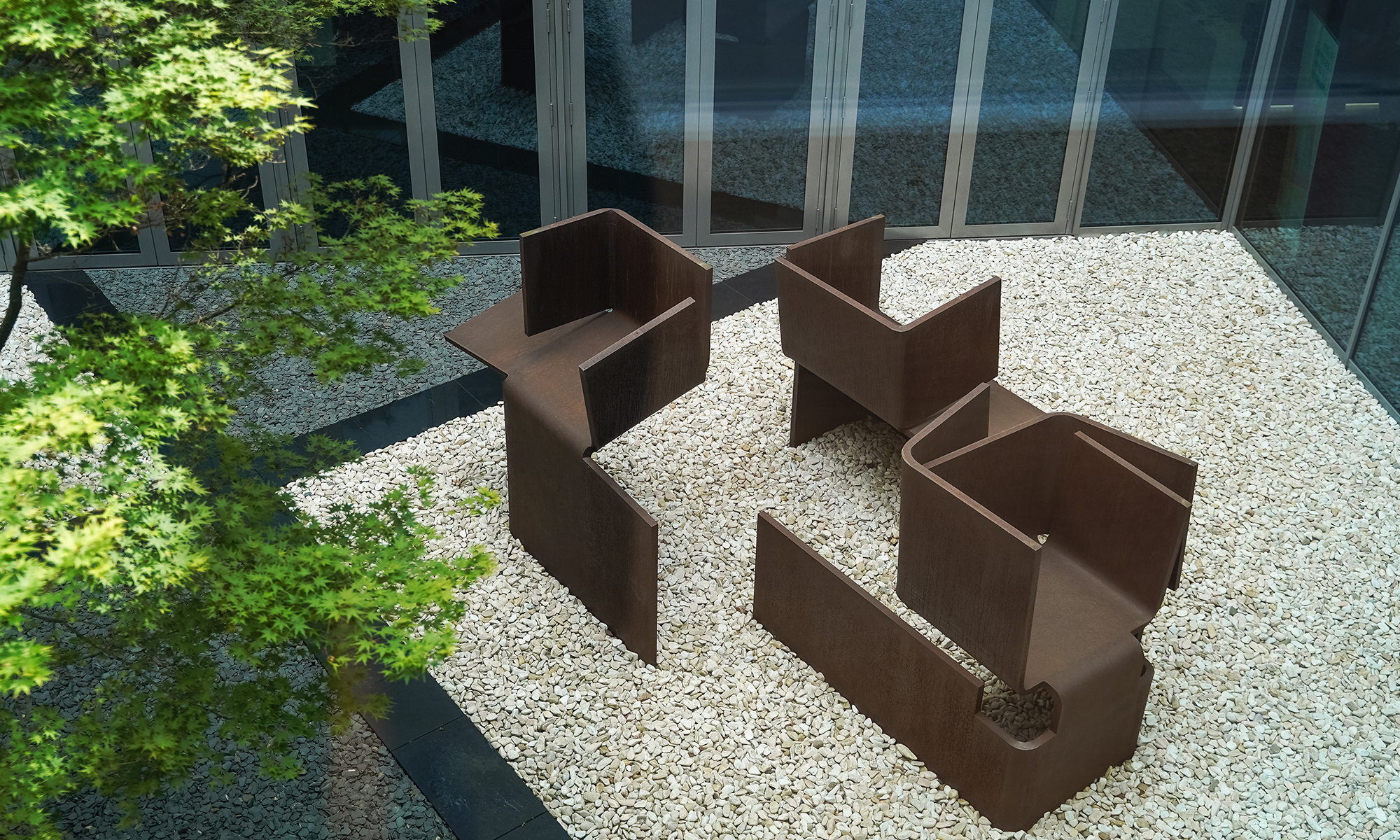
Your journey round the mre collection begins the moment you step into the foyer. Almost all of the works you encounter have been specially designed for the mre.
The architectural and visual design of the museum evolved hand in hand resulting in an outstanding work of art where architecture, painting, installation, glass art and sculpture combine to create an experience which will convince you that abstract art is more relevant today than it has ever been.

Upon first entering the museum, your gaze will be drawn to the three-part sculpture in the glazed inner courtyard, Buscando la luz III by Eduardo Chillida (1924-2002). It stretches up towards the sky, as does the maple tree which is another important feature of the mre foyer. The Spanish title of the work translates as In Search of Light and reflects the elegant form of the piece, reaching upwards towards the sky. The Basque sculptor gave a unique, artistic form to the theme of this universal reaching towards the light. The artist created this sculpture in 2000 as one of a whole series of works with the same title.
In a masterful interplay of curved and cut material, of positive and negative spatial bodies, of lightness and weight, his nine tonnes of Corten steel radiate plastic solidity and filigree grace in equal measure. What the courtyard achieves on a large scale, the sculpture expresses on a small scale. Both capture the light which is literally existential for all living things. This is no coincidence, but stems from kindred artistic thinking.
Fumihiko Maki and Eduardo Chillida, who calls himself the architect of empty spaces, have been friends since 1958, when the 30-year-old architect and the 34-year-old sculptor met in Chicago. Maki then won over Reinhard Ernst with his enthusiasm for the Basque artist.
Buscando la luz III eventually found its place in the heart of the mre thanks to friendship, perseverance and a bit of luck. It took many years for the opportunity to acquire this major work by the world-famous sculptor to arise. With the arrival of the sculpture in the Museum Reinhard Ernst, Wiesbaden has gained a high-calibre ambassador of its town twinning partnership with San Sebastián.
Katharina Grosse’s Ein Glas Wasser, bitte (A Glass of Water, please) lights up the foyer from its position to the left of the reception desk. The artist works tirelessly to make painting something you can experience again and again. She enjoys breaking with the conventions of this tradiitional art form and asking herself – and us – What can painting be? Architecture covered in paint? Yes. Painted natural elements and found objects? Yes. Can we use both brushes and spray paint? Yes. The other works she has contributed to the Reinhard Ernst collection also challenge our understanding of what painting can be.
This pushes her to constantly explore new artistic ground. For example, the piece featured in the mre foyer is the first time she has worked in glass. From the floor to the ceiling, over a total of 60m², she demonstrates the incredible diversity of colour.
It shines and streaks, flows and crawls, drips and swirls, forms crystals and runs riot. It merges with other elements or becomes the surface itself. The effect is breathtaking, especially when the sun shines, a celebration of the exuberant potential of art – and we are right in the middle of it. Grosse is without doubt the best possible artistic host of the colour laboratory – the heart of everything the mre does to bring art and people together is located behind this piece of glass work. In our colour laboratory, researchers of all ages can experiment with the almost inexhaustible manifestations of painting at various digital experimental stations.
In the north-eastern corner of our foyer, you will discover a shimmering rose-gold work by the Wiesbaden artist Karl-Martin Hartmann (born 1948).
Narrow, room-high glass panes extend over two floors, curtaining the view like lengths of fabric and at the same time arousing curiosity about what lays hidden behind. Behind the translucent curtain, a clearing in the forest is revealed. To achieve this effect, the artist transferred photographs of trees onto glass in a complex process (multi-layer rubber printing). The foliage is also made of glass. Hundreds of individual leaves in countless shades of green appear to have fallen to the ground. The roof over the space is constructed from 40 hand-blown mirrors.
In The Ladybird, The Innocence And The Cars Hartmann combines Reinhard Ernst’s passion for art with his love of extraordinary automobiles. In the middle of the clearing stands a Ferrari F40. This car, above all others, represents the state of the art and design of the 1980’s and 1990’s.
Its 478 hp engine elevated it to the top of its street racer class and produced a triumphal roar for the combustion engine and a reminder of the widespread, unshakeable faith the world had in fossil fuels. With the artistically dislocated view of the car, Hartmann creates a light-footed metaphor for an attitude towards power and mobility that is only supposedly now far behind us.
The artist embeds this automotive celebration of design and engineering skill in his fragile, glazed natural scenery. In the reflecting sky, The art work references the car’s colour in the sheltering, reflective sky above. Colourful light is redirected and sparkles kaleidoscopically upwards into the exhibition floor. A gorgeous rosy gold combines with the iconic Ferrari red creating an abstract play of light which sees these very different worlds and times finally reconciled. Something only art can achieve.
How do we get to see art from here? We walk straight through it. Simply follow the guardrails. The Museum Reinhard Ernst extends a stroll along Wiesbaden’s Wilhelmstraße to incorporate a walk through the ground floor of the mre.
Urban space and museum space penetrate each other architecturally in a foyer flooded with light. This is where the urban world makes its artistic entrance. The work of Bettina Pousttchi (born 1971) introduces unusual art materials into the museum. To the left of the main entrance, red metal structures stretch upwards. These are factory-fresh crash barriers that the artist has compressed, bent and deformed with hydraulic presses before finally painting them. In this way, Pousttchi transforms the original functional context of the material and thus draws out its aesthetic quality. It becomes a How do we reach art from here? We walk straight through it. Simply follow the guardrails. The Museum Reinhard Ernst extends a stroll along Wiesbaden’s Wilhelmstraße to incorporate a walk through the ground floor of the mre.
Urban space and museum space penetrate each other architecturally in a foyer flooded with light. This is where the urban world makes its artistic entrance. The work of Bettina Pousttchi (born 1971) introduces unusual art materials into the museum. To the left of the main entrance, red metal structures stretch upwards.
These are factory-fresh crash barriers that the artist has compressed, bent and deformed with hydraulic presses before finally painting them. In this way, Pousttchi destroys the original functional context of the material and thus draws out its aesthetic quality. It becomes a Vertical Highways – Progressions 4 which suggests pedestrians and road-users alike should no longer do the bidding of a metallic grey and horizontal set of guidelines but rather consider a vertical and surprisingly colourful alternative.
which suggests pedestrians and road-users alike should no longer do the bidding of a metallic grey and horizontal set of guidelines but rather consider a vertical and surprisingly colourful alternative.
The artistic transformation and dislocation mean the crash barriers now no longer set any limits. Quite the reverse. Art has nothing to gain from regulated traffic flow and speed restrictions. There is no better way to prepare yourself for a visit to an exhibition. With her largest piece of work to date, Pousttchi provides a taste of some of the artists to come in the Reinhard Ernst collection, artists working in a similar vein such as Frank Stella or John Chamberlain. The way ahead leads us straight through Pousttchi’s sculpure. Her Vertical Highways – Progressions 4 catapults us headlong into the temporary exhibition on the ground floor or up the stairs into the main collection.
Urban space is an important source of inspiration to MadC. Using a spray can and a cherry picker, she transforms bridge sections, walls and multi-storey building façades into paintings. Claudia Walde (born 1980), operating under the street art name MadC, is one of the most recognised graffiti artists worldwide. Five of her works are included in the mre collection and demonstrate the breadth of her experience in the field. The artist takes the powerful luminosity of her occasionally monumental façade painting then condenses it into her work on canvas. She may be using brushes but the transparent application of the acrylic paint and the deliberate run marks are a reminder of the translucent mist of paint and the use of spray cans.
For Wandering Thoughts, Walde has transferred her paintings on to glass. This is quite an artistic challenge. First she breaks down her own careful and interlocking compositions into their constituent pieces. Then, a huge number of individual glass pieces are produced which are then cut, placed and layered beside and over one another until the desired depth, transparency and colour strength is achieved.
Similar to Katharina Grosse and Karl-Martin Hartmann, Walde also worked closely with the Derix Glass Studios in Taunusstein. They were an invaluable source of glass-painting expertise and the artistic sensitivity necessary for her works’ realisation. Thanks to this mutually appreciative cooperation between the artist and the glass experts, the mre function rooms are also an artistic delight. Claudia Walde’s colour, transparency and light create a unique artistic atmosphere for numerous locations throughout the mre.
Stepping into the public areas of the mre, it is clear that our museum is not only home to the abstract art of the past. Eduardo Chillida, Katharina Grosse, Karl-Martin Hartmann, Bettina Pousttchi and Claudia Walde prove that any number of contemporary artists are continuing to add new and exciting chapters to the evolving story of abstraction.